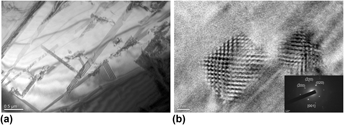Article contents
Effects of aging on shape memory and wear resistance of a Fe–Mn–Si-based alloy
Published online by Cambridge University Press: 21 November 2014
Abstract

The influence of aging treatment on shape memory effect (SME) and wear resistance of Fe–20Mn–5Si–10Cr–5Ni–0.7V–0.2N (mass%) alloy was investigated. Results showed that vanadium nitride (VN) particles precipitated during aging treatment, and the amount and size of the particles increased with increasing aging time. The sample aged for 8 h exhibited the maximal shape recovery ratio of 74% (compared with that of 16% for unaged) and favorable wear resistance in both dry wear and oil-lubricant wear conditions. The fine VN particles are the key factor to improve the SME by strengthening the alloy and acting as preferential nucleation sites for martensite. However, more and larger particles due to further aging treatment appeared to have negative effects on the SME and wear resistance. After oil-lubricant friction, there existed large amounts of friction-stress-induced ε martensite in the worn surface of the sample. As a result, the wear resistance of samples in oil-lubricant wear condition was remarkably higher than that in dry wear condition.
- Type
- Articles
- Information
- Copyright
- Copyright © Materials Research Society 2014
References
REFERENCES
- 11
- Cited by




